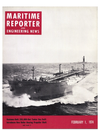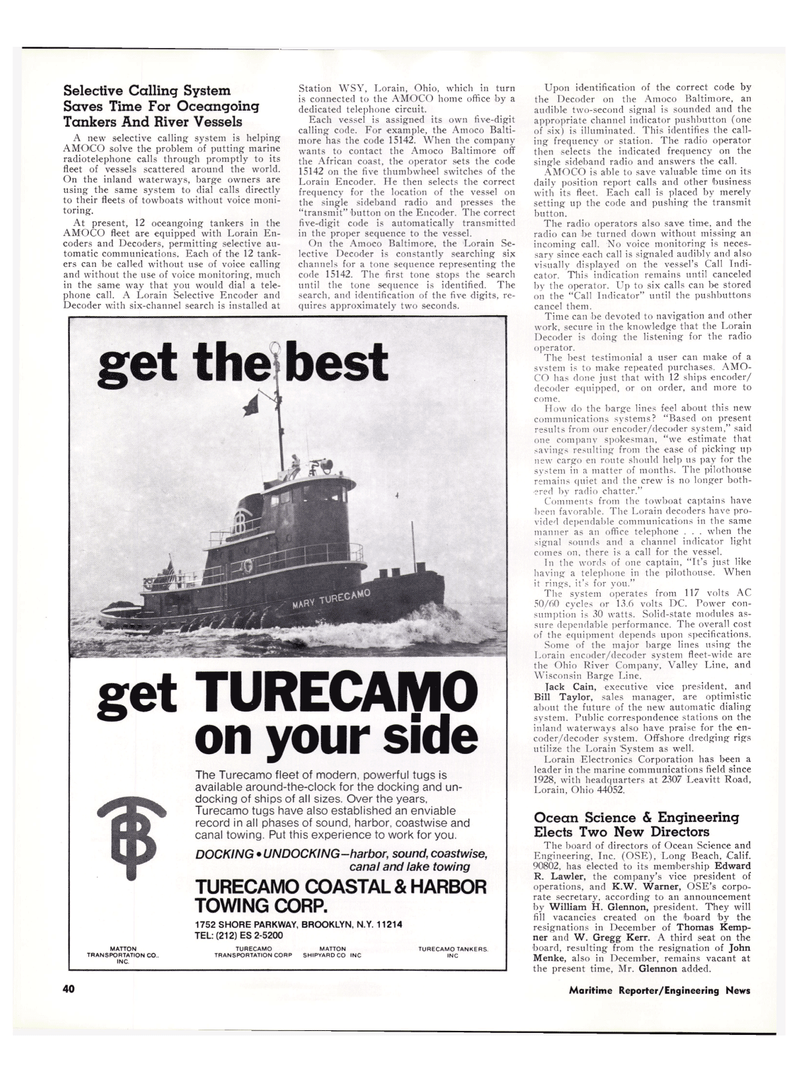
Page 4th Cover: of Maritime Reporter Magazine (February 1974)
Read this page in Pdf, Flash or Html5 edition of February 1974 Maritime Reporter Magazine
Selective Calling System
Saves Time For Oceangoing
Tankers And River Vessels
A new selective calling system is helping
AMOCO solve the problem of putting marine radiotelephone calls through promptly to its fleet of vessels scattered around the world.
On the inland waterways, barge owners are using the same system to dial calls directly to their fleets of towboats without voice moni- toring.
At present, 12 oceangoing tankers in the
AMOCO fleet are equipped with Lorain En- coders and Decoders, permitting selective au- tomatic communications. Each of the 12 tank- ers can be called without use of voice calling and without the use of voice monitoring, much in the same way that you would dial a tele- phone call. A Lorain Selective Encoder and
Decoder with six-channel search is installed at
Station WSY, Lorain, Ohio, which in turn is connected to the AMOCO home office by a dedicated telephone circuit.
Each vessel is assigned its own five-digit calling code. For example, the Amoco Balti- more has the code 15142. When the company wants to contact the Amoco Baltimore off the African coast, the operator sets the code 15142 on the five thumbwheel switches of the
Lorain Encoder. He then selects the correct frequency for the location of the vessel on the single sideband radio and presses the "transmit" button on the Encoder. The correct five-digit code is automatically transmitted in the proper sequence to the vessel.
On the Amoco Baltimore, the Lorain Se- lective Decoder is constantly searching six channels for a tone sequence representing the code 15142. The first tone stops the search until the tone sequence is identified. The search, and identification of the five digits, re- quires approximately two seconds.
Upon identification of the correct code by the Decoder on the Amoco Baltimore, an audible two-second signal is sounded and the appropriate channel indicator pushbutton (one of six) is illuminated. This identifies the call- ing frequency or station. The radio operator then selects the indicated frequency on the single sideband radio and answers the call.
AMOCO is able to save valuable time on its daily position report calls and other business with its fleet. Each call is placed by merely setting up the code and pushing the transmit button.
The radio operators also save time, and the radio can be turned down without missing an incoming call. No voice monitoring is neces- sary since each call is signaled audibly and also visually displayed on the vessel's Call Indi- cator. This indication remains until canceled by the operator. Up to six calls can be stored on the "Call Indicator" until the pushbuttons cancel them.
Time can be devoted to navigation and other work, secure in the knowledge that the Lorain
Decoder is doing the listening for the radio operator.
The best testimonial a user can make of a system is to make repeated purchases. AMO-
CO has done just that with 12 ships encoder/ decoder equipped, or on order, and more to come.
How do the barge lines feel about this new communications systems? "Based on present results from our encoder/decoder system," said one company spokesman, "we estimate that savings resulting from the ease of picking up new cargo en route should help us pay for the system in a matter of months. The pilothouse remains quiet and the crew is no longer both- ered by radio chatter."
Comments from the towboat captains have been favorable. The Lorain decoders have pro- vided dependable communications in the same manner as an office telephone . . . when the signal sounds and a channel indicator light comes on. there is a call for the vessel.
In the words of one captain, "Tt's just like having a telephone in the pilothouse. When it rings, it's for you."
The system operates from 117 volts AC 50/fi0 cycles or 13.6 volts DC. Power con- sumption is 30 watts. Solid-state modules as- sure dependable performance. The overall cost of the equipment depends upon specifications.
Some of the major barge lines using the
Lorain encoder/decoder system fleet-wide are the Ohio River Company, Valley Line, and
Wisconsin Barge Line.
Tack Cain, executive vice president, and
Bill Taylor, sales manager, are optimistic about the future of the new automatic dialing system. Public correspondence stations on the inland waterways also have praise for the en- coder/decoder system. Offshore dredging rigs utilize the Lorain 'System as well.
Lorain Electronics Corporation has been a leader in the marine communications field since 1928, with headquarters at 2307 Leavitt Road,
Lorain, Ohio 44052.
Ocean Science & Engineering
Elects Two New Directors
The board of directors of Ocean Science and
Engineering, Inc. (OSE), Long Beach, Calif. 90802, has elected to its membership Edward
R. Lawler, the company's vice president of operations, and K.W. Warner, OSE's corpo- rate secretary, according to an announcement by William H. Glennon, president. They will fill vacancies created on the board by the resignations in December of Thomas Kemp- ner and W. Gregg Kerr. A third seat on the board, resulting from the resignation of John
Menke, also in December, remains vacant at the present time, Mr. Glennon added. get TURECAMO on your side
The Turecamo fleet of modern, powerful tugs is available around-the-clock for the docking and un- docking of ships of all sizes. Over the years,
Turecamo tugs have also established an enviable record in all phases of sound, harbor, coastwise and canal towing. Put this experience to work for you.
DOCKING • UNDOCKING—harbor, sound, coastwise, canal and lake towing
TURECAMO COASTAL & HARBOR
TOWING CORP. 1752 SHORE PARKWAY, BROOKLYN, N.Y. 11214
TEL: (212) ES 2-5200
MATTON
TRANSPORTATION CO..
INC
TURECAMO
TRANSPORTATION CORP
MATTON
SHIPYARD CO INC
TURECAMO TANKERS
INC 40 Maritime Reporter/Engineering News

 3rd Cover
3rd Cover

